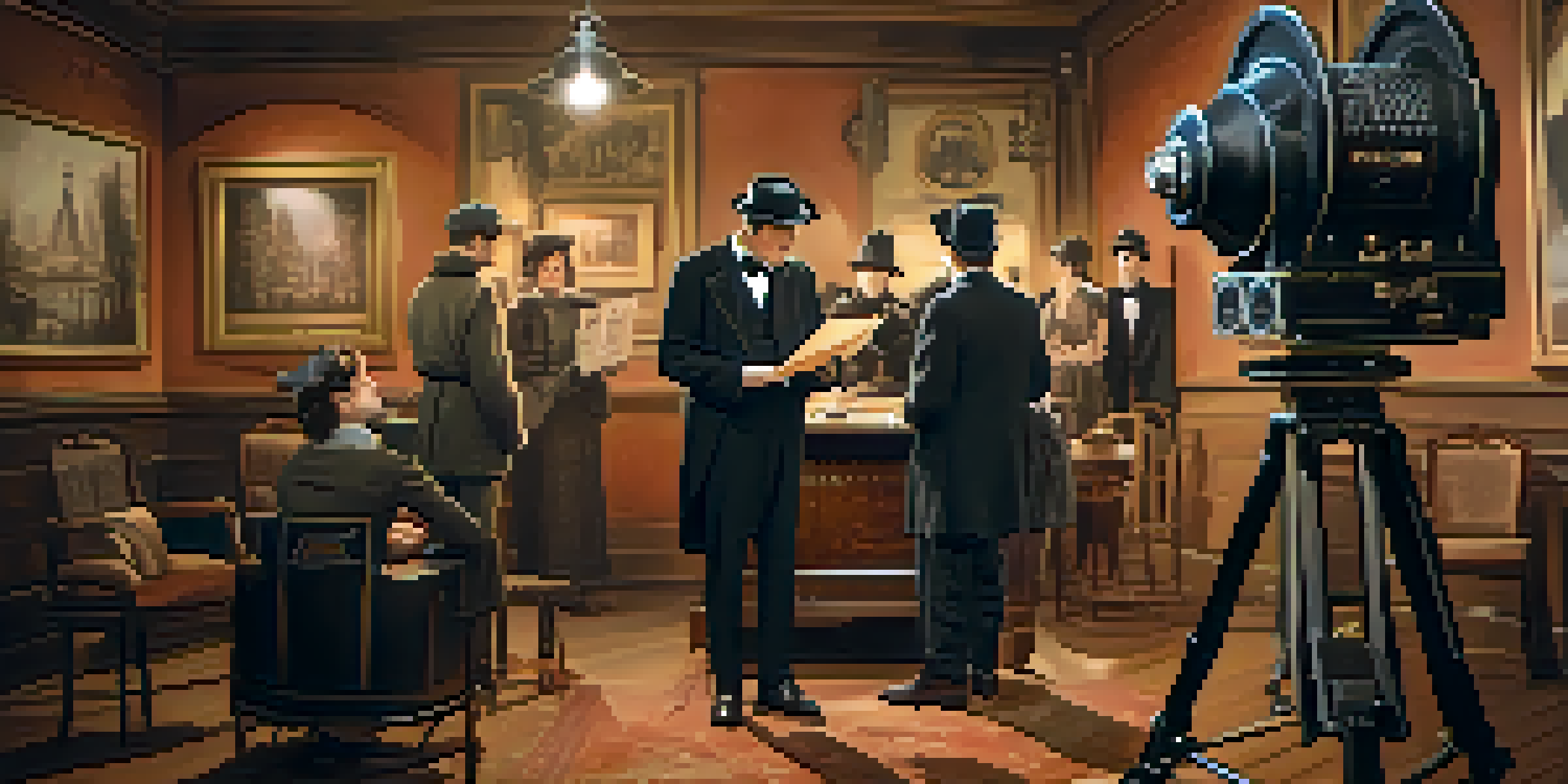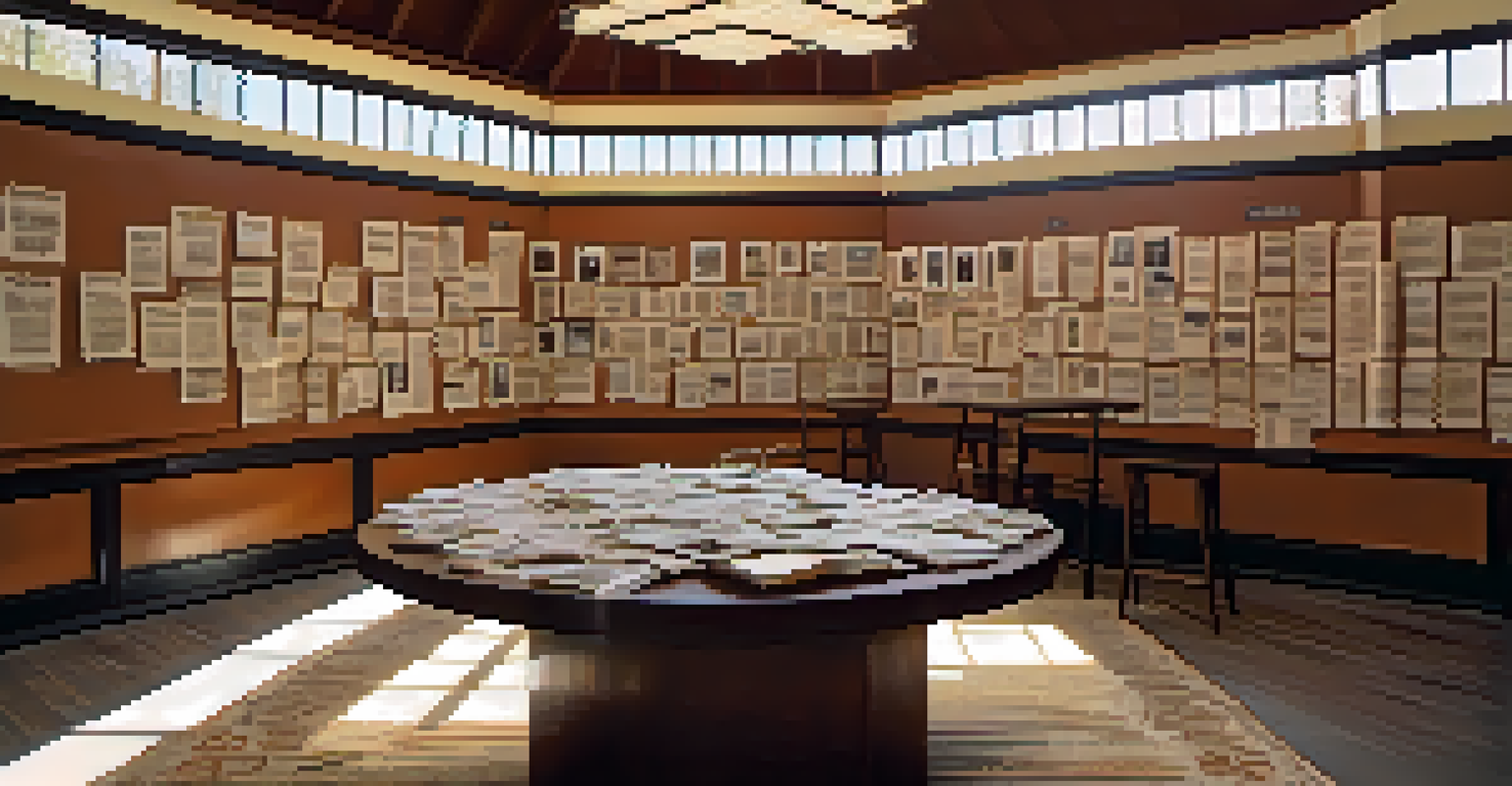The Evolution of Screenplays: From Classic to Modern Films

The Birth of Screenplays: Early Beginnings and Silent Films
The screenplay as we know it today was virtually non-existent in the early days of cinema. During the silent film era, filmmakers relied heavily on visual storytelling, using title cards to convey dialogue and exposition. This reliance on imagery laid the groundwork for future storytelling techniques, emphasizing the importance of visual narrative.
The screenplay is a blueprint of the film; it is the foundation upon which the entire structure is built.
As films transitioned to sound in the late 1920s, the need for more structured scripts became evident. Filmmakers began to write screenplays that included dialogue and scene descriptions, marking a significant evolution in how stories were crafted for the screen. This shift allowed for more nuanced character development and intricate plots.
Classic films like 'Gone with the Wind' and 'Casablanca' showcased the potential of the screenplay, blending dialogue with dramatic visuals. These early screenwriters paved the way for a new art form, emphasizing that a well-crafted script could elevate a film from mere entertainment to a timeless classic.
The Golden Age of Hollywood: Scriptwriting Takes Center Stage
The Golden Age of Hollywood saw a surge in the importance of screenplays, with a focus on strong narratives and character arcs. Screenwriters like Billy Wilder and Frances Goodrich became household names, known for their ability to craft captivating stories that resonated with audiences. Their work highlighted the screenplay as a vital component of filmmaking.

During this era, studios began to recognize the value of script development, leading to the establishment of screenwriting departments. This not only professionalized the craft but also encouraged collaboration between writers, directors, and producers. The emphasis on teamwork resulted in films that were richer in content and more engaging for viewers.
Evolution of Screenplays Over Time
Screenplays have evolved from simple visual storytelling in silent films to complex narratives with dialogue and structure in modern cinema.
Iconic films such as 'The Wizard of Oz' and 'Citizen Kane' emerged from this period, showcasing innovative storytelling techniques. These films often featured complex characters and intricate plots, demonstrating the power of a well-structured screenplay to create lasting impact and cultural significance.
The Rise of Independent Cinema: New Voices and Fresh Perspectives
The 1960s and 1970s marked a turning point in screenwriting with the rise of independent cinema. Filmmakers began to break away from the traditional studio system, allowing for more personal and unconventional storytelling. This shift opened the door for new voices and perspectives that challenged the status quo.
Screenwriting is the most exciting form of writing, and it’s the most challenging. It’s the art of telling a story through images and sound.
Writers like John Cassavetes and Woody Allen emphasized character-driven narratives over formulaic plots, showcasing the potential for emotional depth in film. Their stories often reflected real-life struggles and societal issues, resonating with audiences on a more personal level. This democratization of filmmaking allowed for greater creativity and experimentation.
Films such as 'Easy Rider' and 'Annie Hall' became cultural touchstones, proving that screenplays could be both innovative and commercially successful. This era laid the foundation for a diverse array of storytelling styles that continue to influence modern filmmakers today.
The Impact of Technology: Screenwriting in the Digital Age
The advent of digital technology has transformed the way screenplays are written, produced, and distributed. Screenwriters now have access to advanced software that streamlines the writing process, allowing for easy formatting and organization. This technological shift has made screenwriting more accessible to aspiring writers worldwide.
Online platforms and communities have emerged, enabling screenwriters to share their work and receive feedback from peers. This has fostered a collaborative spirit within the industry, encouraging writers to refine their craft and explore new ideas. The exchange of knowledge and creativity has never been easier.
Diversity and Representation Matter
Recent efforts in screenwriting focus on including underrepresented voices, leading to richer narratives that resonate with a broader audience.
Modern films often incorporate cross-media storytelling, blending traditional screenplays with elements from video games and social media. This evolution reflects the changing landscape of storytelling, where narratives are no longer confined to one medium, but rather expand across multiple platforms, creating a more immersive experience for audiences.
Diversity in Storytelling: Expanding Representation in Screenplays
In recent years, there has been a growing emphasis on diversity in screenwriting, with a focus on underrepresented voices. Filmmakers are increasingly aware of the importance of authentic representation in storytelling, leading to a richer tapestry of narratives. This shift is vital in reflecting the diverse world we live in.
Writers from various backgrounds are bringing unique perspectives to the forefront, resulting in stories that resonate with a broader audience. Films like 'Black Panther' and 'Crazy Rich Asians' demonstrate the success of inclusive storytelling, proving that diverse narratives can achieve both critical acclaim and commercial success.
The push for diversity in screenwriting not only enriches the film industry but also challenges stereotypes and fosters understanding. As more voices are heard, the landscape of modern cinema continues to evolve, encouraging empathy and connection among audiences.
Genre-Bending: The Fusion of Styles in Modern Screenplays
Modern screenplays often defy traditional genre classifications, blending elements from multiple genres to create unique narratives. This genre-bending approach allows filmmakers to experiment with storytelling techniques and engage audiences in fresh ways. For example, films like 'Get Out' combine horror and social commentary, creating a thought-provoking experience.
This fusion of styles reflects a broader trend in contemporary cinema, where rigid genre boundaries are increasingly blurred. Screenwriters are encouraged to push the envelope, drawing inspiration from various influences to craft compelling stories that resonate with diverse audiences. This creativity keeps the film landscape dynamic and exciting.
Technology's Role in Screenwriting
Digital advancements and online platforms have transformed screenwriting, making it more accessible and collaborative for aspiring writers.
As a result, viewers are treated to a wide array of innovative films that challenge expectations. The boldness of modern screenwriting continues to inspire future generations of filmmakers, encouraging them to explore new narratives and redefine what cinema can be.
The Future of Screenplays: Trends and Predictions
Looking ahead, the future of screenplays is likely to be shaped by ongoing technological advancements and evolving audience preferences. As virtual and augmented reality gain traction, screenwriters may need to adapt their storytelling techniques to create immersive experiences. This shift represents an exciting opportunity for innovation in the craft.
Moreover, with the rise of streaming platforms, there is an increasing demand for fresh content. Screenwriters have the chance to explore unconventional narratives and cater to niche audiences, resulting in a broader range of stories being told. This democratization of content distribution opens doors for aspiring writers to showcase their work.

Ultimately, the evolution of screenplays reflects the ever-changing landscape of storytelling in film. As filmmakers continue to push boundaries and embrace new technologies, we can expect a vibrant and diverse future for screenwriting that captivates audiences for generations to come.